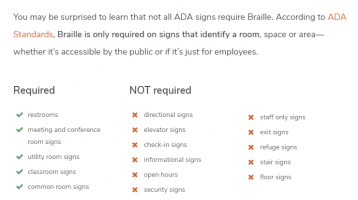2010 ADA Standards: You have to start in Chapter 2, Scoping Requirements. That will then direct you to the applicable technical requirements in the other chapters.
"216.2 Designations. Interior and exterior signs identifying permanent rooms and spaces shall comply with 703.1, 703.2, and 703.5. Where pictograms are provided as designations of permanent interior rooms and spaces, the pictograms shall comply with 703.6 and shall have text descriptors complying with 703.2 and 703.5."
"216.4.1 Exit Doors. Doors at exit passageways, exit discharge, and exit stairways shall be identified by tactile signs complying with 703.1, 703.2, and 703.5."
"703.1 General. Signs shall comply with 703. Where both visual and tactile characters are required, either one sign with both visual and tactile characters, or two separate signs, one with visual, and one with tactile characters, shall be provided."
"703.2 Raised Characters. Raised characters shall comply with 703.2 and shall be duplicated in braille complying with 703.3. Raised characters shall be installed in accordance with 703.4."
"703.3 Braille. Braille shall be contracted (Grade 2) and shall comply with 703.3 and 703.4."
"703.5 Visual Characters. Visual characters shall comply with 703.5."
Directional and informational signs and accessible means of egress directional signs do not require tactile characters (neither has a reference to Section 703.2), just compliance with Section 703.5, which only requires signage with visual characters of a certain size, stroke, spacing, and contrast.
Permanent room/space signs are not required, but if you do provide them, then you have to have visual and tactile characters (raised letters and braille). Exit doors are required to have signage with both visual and tactile characters. Restrooms need only provide signage per Section 703.5.

